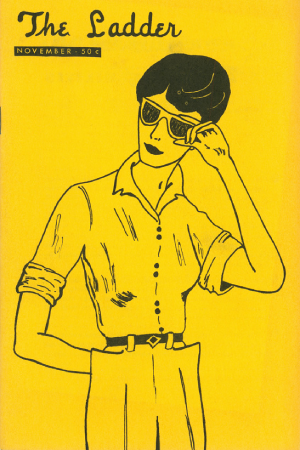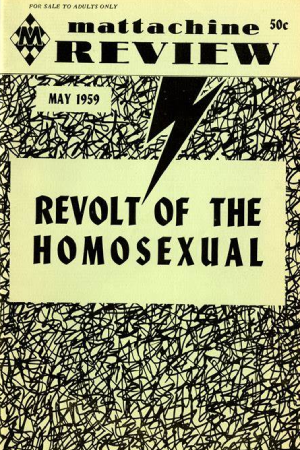The Ladder

The Ladder was the first nationally distributed lesbian publication in the United States. It was published monthly from 1956 to 1970, and once every other month in 1971 and 1972. It was the primary publication and method of communication for the Daughters of Bilitis. The name of the magazine was derived from the artwork on its first cover, simple line drawings showing figures moving towards a ladder that disappeared into the clouds.
The first lesbian publication in the United States was a newsletter called Vice Versa. It was created and edited by a secretary named Edith Eyde who used the pseudonym Lisa Ben, an anagram of "lesbian". It was distributed privately in the LA area from 1947 to 1948.
The first issues of the magazine averaged roughly 20 pages with each issue increasing in length from 12 pages to 30 pages by the end of the first volume. It included book reviews, news, poetry, short stories, a running bibliography of lesbian literature, letters from readers, and updates from DOB meetings.
In 1963 Barbara Gittings took over editing The Ladder, giving it a more politically urgent stance and adding "A Lesbian Review" under the title of the magazine. The line drawings on the cover were replaced with photographs of lesbians, to make them more visible.
One

In January 1953 ONE Inc. began publishing a monthly magazine called One, the first U.S. pro-gay publication which sold openly on the streets of Los Angeles for 25 cents. In October 1954, the U.S. Post Office Department declared the magazine "obscene, lewd, lascivious, and filthy" and refused to deliver it. ONE Inc. brought a lawsuit in federal court, which it won in 1958, when the U.S. Supreme Court reversed the lower court ruling in One, Inc. v. Olesen based on its recent landmark First Amendment case, Roth v. United States. The magazine ceased publication in December 1969.
One, Inc. v. Olesen, was a landmark decision of the US Supreme Court for LGBT rights in the United States. It was the first U.S. Supreme Court ruling to deal with homosexuality and the first to address free speech rights with respect to homosexuality. The Supreme Court reversed a lower court ruling that the gay magazine ONE violated obscenity laws, thus upholding constitutional protection for pro-homosexual writing.
In 1956, ONE established the ONE Institute of Homophile Studies which, in addition to organizing classes and annual conferences, also published the ONE Institute Quarterly, a journal dedicated to the academic exploration of homosexuality.
The Mattachine Review

In January 1955 the Mattachine Review became the nation's second widely circulated magazine published by and for the fledgling gay and lesbian community. Published two years after ONE was originally published, the Mattachine Review operated independently from the society. Although the two publications shared the common goal of eradicating political injustice and social prejudice aimed at homosexuals, the Review adopted a milder tone in keeping with the noncombative, assimilationist perspective of the Mattachine Society.
The magazine reflected Mattachine Society's belief that homosexuals would gain social acceptance throught education. It's goal was to "build bridges" by publishing the work of progressive experts. The Mattachine Review began publication during the anticommunist and antigay hysteria of McCarthyism, testimony to the determination of its organizers to confront the social intolerance of that era.
Each issue contained a mix of original essays on the homosexual experience; reprints of scientific studies related to homosexuality; poetry with a homosexual theme; reviews of books related to homosexuality; and letters to the editor to give readers "the true facts of the Mattachine Society and the place of the sex variant in the life of the community"